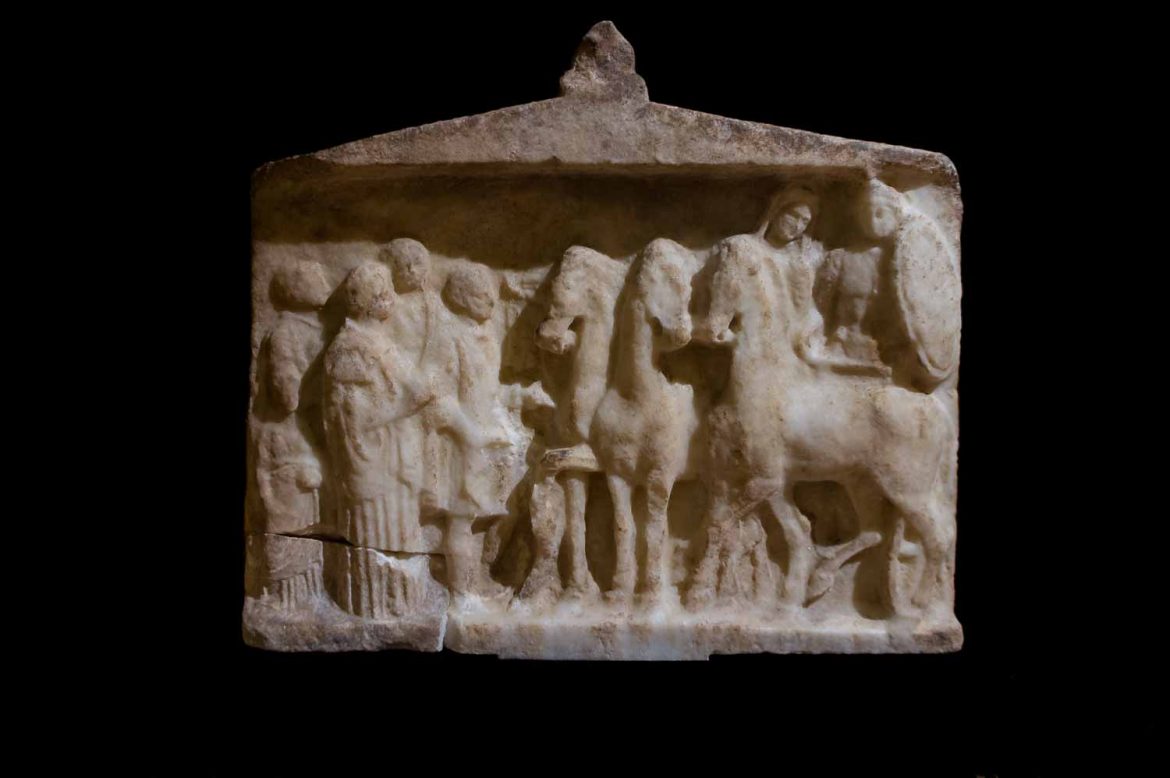Thessalian Votive Relief
Pentelic marble
h.43cm, w.52cm
350-325 BC
The rectangular slab of greater width than height has a smooth fillet at the base and no lateral frame. It is crowned with a triangular pediment with a central acroterion which displays a curvilinear profile. A similar conformation is visible on other votive reliefs made in Thessaly in the 4th century BC. A tenon on the base fillet served to attach the relief to a sup- port. The back is rough-hewn and bears visible marks of the stonemason’s chisel. The surface of the sides is left rough.
The scene in the figured field juxtaposes two figures mounted on a quadriga with a group of five standing figures (in “Athena Nike: la vittoria della dea”, Rome 2013, p. 118-215). Standing on the chariot is a male figure with his body in frontal view. He wears an anatomical cuirass from which the short sleeve of a chiton emerges. His right-hand rests on the chariot parapet and there is a large circular shield on his left arm. The head, turned in three-quarter profile to his right, is encased in a helmet possibly with cheek guards and a crest (lophos). To the warrior’s right is a female figure with her head turned in three-quarter profile to her left and covered with part of her cloak like a veil. The horses are carefully carved, as shown by the muscle bodies and the accurate anatomical lines, in different attitudes and poses. The two figures on the chariot, who attract the viewer’s attention by virtue of their frontal presentation and solemn composure, can be identified as the divine or heroic couple to which the relief was dedicated and the figures on the left as a group of worshippers, probably united by family ties, bearing offerings or raising their right hands in the gesture of prayer.
The relief displays sensitive, sophisticated workmanship that unfortunately cannot be fully appreciated due to the severe wear of the surface, which has left the forms indistinct and erased the details. Traces of the original skill survive in the thrusting heads of the horses, the fluid, vibrant rendering of their anatomy, the narrow incisions that define the details of their legs, the minute folds that animate the drapery, and the delicate features of the human faces.
The vivacity of the scene was probably enhanced by painting so as to make the figures stand out against the background, endow them with greater natural- ness, and define and animate the details.
The central acroterion was unquestionably completed with a painted anthemion and there may have been a painted inscription. It is precisely the Thessalian votive reliefs that provide the most precise terms of comparison for the Fondazione Sorgente Group Collection work, which can be regarded on both typological and iconographic and compositional grounds as part of a homogeneous series, probably attributable to the same workshop, which includes the following.
The Fondazione Sorgente Group Collection relief shows similarities to the fragment from Krannon, in Larissa, the one from Mylai in Halmayros and the one in Malibu, in the J. Paul Getty Museum. The dedication carved on the Getty relief makes it possible to identify the warrior on the quadriga as the hero Achilles, the son of the local Thessalian ruler Peleus and therefore worshipped in the region.
While it has recently been suggested that the female figure beside him is his wife Deidamia, daughter of King Lycomedes, it appears more reasonable to accept her earlier identification as his mother Thetis, who took his remains after his death at Troy to Leuke, the isle of the blessed, where he was worshipped as a god or hero. The pursuit of spatial depth, the accumulation and distribution of the faithful on different planes and the tendency towards frontal presentation of the figures suggest that the Fondazione Sorgente Group Collection relief can be assigned a date in the third quarter of the 4th century BC.


